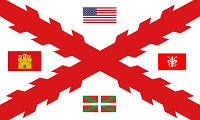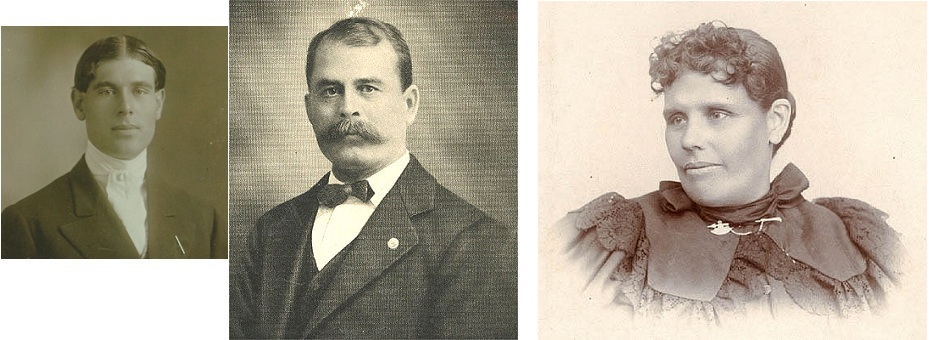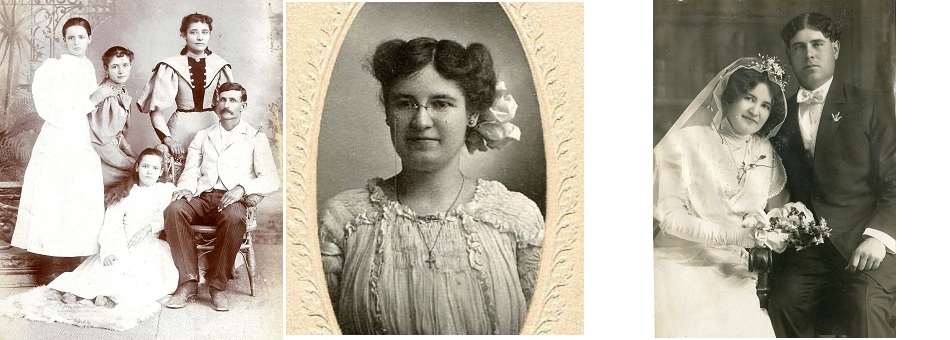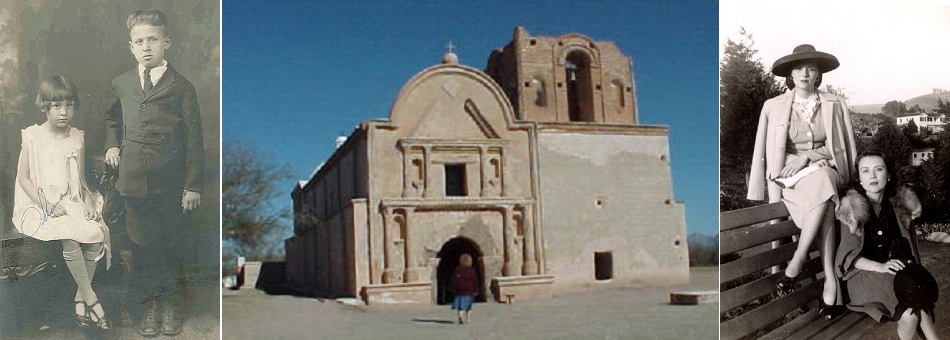FLORENCE'S FOUNDATIONS
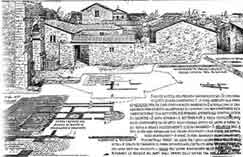 The
foundation of Florence dates back to Roman times, despite evidence existing to
show that Florence was already occupied in prehistoric times. The oldest part of
the city bears the imprint of these Roman origins as it originated as one of
Caesar's colonies. For the sake of defense, the city was set at the confluence
of two streams, the Arno and the Mugnone, where the oldest populations had
previously been located.
The
foundation of Florence dates back to Roman times, despite evidence existing to
show that Florence was already occupied in prehistoric times. The oldest part of
the city bears the imprint of these Roman origins as it originated as one of
Caesar's colonies. For the sake of defense, the city was set at the confluence
of two streams, the Arno and the Mugnone, where the oldest populations had
previously been located.
Rectangular in plan, it was enclosed in a wall about 1800 meters long. The
built-up area, like all the cities founded by the Romans, was characterized by
straight roads which crossed at right angles. The two main roads led to four
towered gates and converged on a central square, the forum urbis, now Piazza
della Repubblica, where the Curia and the Temple dedicated to the Capitoline
Triad (Jupiter, Juno, and Minerva) were later to rise. Archaeological finds,
many of which came to light during the course of works which "gave new life", to
the old city center, have made it possible to locate and identify the remains of
various important public works such as the Capitoline Baths, the Baths of
Capaccio, the sewage system, the pavement of the streets and the Temple of Isis,
in Piazza San Firenze. At that time the Arno was outside the walls, with a river
port that constituted an important infrastructure for the city, for in Roman
times the river was navigable from its mouth up to its confluence with the
Affrico, upstream from Florence, and the first bridge in Florentine history was
built in all likelihood somewhat upstream from today's Ponte Vecchio, around the
first century B.C..
The city developed rapidly thanks to its favorable position and the role it
played in the ambit of the territorial organization in the region and it soon
superceded Arezzo as the leading center in northern Etruria. Economic power was
the driving force behind the urban growth of the young colony. Commercial
activity and trade thrived thanks to the fact that important communications
routes, land and water, intersected at Florentia and offer an explanation for
the presence of those oriental merchants, probably on their way from Pisa, who
first introduced the cult of Isis and then, in the 2nd century, Christianity.
The earliest indications of the Christian religion are bound to the cults of the
deacon Lorenzo and the Palestinian saint, Felicita and so the first Florentine
churches were built: San Lorenzo consecrated in 393, the first diocese, and
Santa Felicita, whose origins go back to the 4th and 5th centuries. However, the
Florentines do not seem to have had a bishop prior to the late 3rd century. The
first one recorded is San Felice who participated in a Roman synod in 313.
Website - Read More: Research about Florence upon archeological's findings of the Roman Age
 THE
BYZANTINE AND LOMBARD PERIOD
THE
BYZANTINE AND LOMBARD PERIOD
The Barbarian invasions seriously
impaired the importance of Florentia. In 405, the city managed to halt the
hordes of Radagaisus, but later it could not avoid being involved in the
disastrous Gotho- Byzantine war. Its strategic position as bridgehead on the
Arno and strong point in the communications route between Rome and Padania
explains why the city was so keenly contested between the Goths and the
Byzantines. In 541-44 new city walls were built utilizing the structures of
various large Roman buildings: the Campidoglio, the reservoir for the water of
the Baths and the Theater. The wall was trapezoidal and its modest size
testifies to the decline of the city, greatly depopulated; there may have been
less than a thousand inhabitants.
Around the end of the 6th century when the Lombards conquered northern and
central Italy, Florence also fell under their dominion. This was the beginning
of what may be considered the darkest period in the city's history. Cut off from
the major routes, the main reason for its existence suddenly vanished. For their
north-south communications, the Lombards abandoned the central Bologna-Pistoia-Florence
route as being too exposed to the incursions of the Byzantines who still held
control of the eastern part of Italy and Lucca was chosen as the capital of the
duchy of Tuscany as it lay along the road they used for internal communications.
In any case, during the period of Lombard domination, especially after Queen
Theodolinda had been converted to the church of Rome, a number of religious
buildings were founded in the city, including the Baptistery of San Giovanni (St.John
the Baptist) although not of course in its present form and size and its
foundations are still visible in the "subterraneans" of the church.
THE CAROLINGIAN PERIOD
In the Carolingian Period, 8th
century, a feudal system was installed and Florence became a county of the Holy
Roman Empire. Various facts seem to testify to a revival of the city in
Carolingian times: in the 9th century a public ecclesiastic school was set up
and the bridge over the Arno, which had previously been destroyed, seems to have
been rebuilt. At the turn of the century new city-walls were built, probably for
fear of the Hungarian invasions. This third set of walls partly followed the
line of the old Roman walls, widening on the south to enclose the suburbs which
had grown with prosperity while to the north, for political reasons, the
Baptistery, Santa Reparata, the Bishop's Palace, and the adjacent Palatium Regis
where the Emperor's representative held his court of justice, were excluded.
Towards the end of the 10th century, Countess Willa, widow of the Marquis of
Tuscany, who owned an entire district within the city-walls, founded and richly
endowed a Benedictine abbey in memory of her husband called the "Badia
Fiorentina". Countess Willa's son, Hugo, greatly contributed to the development
of Florence thanks to his decision to leave Lucca. His choice of the city on the
banks of the Arno as his dwelling place reinforced its administrative character.
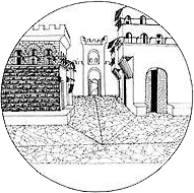 EARLY
MIDDLE AGE
EARLY
MIDDLE AGE
Around the middle of the 11th
century the position of Florence in Tuscany became even more important because
Lucca was no longer the seat of the marquisate and because of the city's
decisive participation in the movement for the reform of the church. The
struggle to eliminate secular interference in ecclesiastical affairs and the
affirmation of the independence of the papacy from imperial power were to have
their leading representative in San Giovanni Gualberto, the son of a Florentine
knight, who founded the order of Vallombrosa.
In 1055 Florence even played host to a council, under Pope Victor II with the
presence of Emperor Henry III and the participation of 120 bishops. Many old
structures were rebuilt during the second half of the 11th century, the
cathedral of Santa Reparata, the Baptistery and San Lorenzo among others. On
November 6, 1059, Bishop Gerard, who had become pope under the name of Nicholas
II, reconsecrated the ancient baptismal church of the city which had been
rebuilt in more imposing form, much like what it is today. The building,
octagonal in plan, with a semicircular apse on one side and three entrances,
seems to have been covered by a pointed-arch dome divided into eight sectors and
the outside was not yet faced with its fine marble casing.
After the death of her mother and of her husband (Geoffrey the Bearded), Matilda, daughter of Countess Beatrice, became the sole countess of Tuscany. She had always adhered to the ideas of the Reform and the policies of San Giovanni Gualberto and during the struggle for investiture she gave her support to the most influential of the reformers, Hildebrand of Sovana who later became Pope Gregory VII, thus finding herself in open contrast with the emperor, Henry IV. After the episode of Canossa, Henry IV's victory in 1081 led to the official deposition of the Countess who was abandoned by all the Tuscan cities except Florence. This faithfulness to the deposed Countess cost the city an imperial siege in July of 1082, which failed. Matilda's special attachment to Florence and the consequent rupture with the emperor led to the construction, in 1078, of a more efficient system of defense and the city was supplied with new walls - those which Dante was to call "la cerchia antica". This fourth walled enclosure for the most part followed along the lines of the Carolingian walls but on the north included the Baptistery, the cathedral of Santa Reparata and the residence of the Countess. In this period the city was divided into quarters which took their names from the four main gates: the Porta San Piero on the east, the so-called "Porta del vescovo" to the north, the Porta San Pancrazio to the west and the Porta Santa Maria to the south.
Like all the early medieval cities, the town plan of 11th century Florence must have been characterized not only by the recovery of its antique urban structure (walls, various remnants of roads) but by a basic homogenity, expressed in a casual distribution of the various landmarks, the most important of which were probably the religious buildings.
THE PERIOD OF THE "COMMUNES"
When Countess Matilda died in 1115 the Florentine populace to all effects already constituted a Commune. The numerous privileges conceded by her and the events in which the Florentine community had played a leading role in the struggle against the emperor, induced the people to organize autonomously and to undertake action aimed at weakening imperial power. It was therefore inevitable that in 1125, upon the death of the last emperor of the Franconian dynasty, Henry V, the Florentines decided to attack and destroy Fiesole, the neighboring rival city. As a result the two counties were conclusively united and remained as separate entities only on an ecclesiastic level with Fiesole maintaining its own diocese.
The first mention of an officially constituted Commune dates to 1138, when at a meeting of the Tuscan cities it was decided to constitute a League, for fear that Henry the Proud who had in precedence oppressed them as imperial legate might be elected emperor. At that time the community wasmade up of religious and secular representatives, with three dominant social groups: the nobles, grouped into consorterie, the merchants, and the horse soldiers, the backbone of the army. Although the nobles held most of the power in the 12th century, it was nevertheless mainly the merchants who were responsible for the growth of the city. The rise of the merchants accelerated in the second half of the century, as trade with distant countries was intensified and became a new and much richer source for the accumulation of capital. Extensive trade and its inseparable companion, credit, were the basis for the economic and demographic expansion of the city.
This process of expansion underwent a temporary halt when Frederick Barbarossa advanced south into Italy. In 1185 the emperor even deprived the city of its contado and restored the marquisate of Tuscany, but the provision had a brief life. In 1197, taking advantage of the death of Barbarossa's successor, Henry VI, Florence regained control of her contado.
Clear evidence of the power Florence had acquired in the course of the 12th century is to be found in the expansion of its urban territory. All around the circle of Matilda's walls, in correspondence to the gates, populous suburbs had sprung up. In 1172 the Commune therefore decided to enlarge the city walls and incorporate the newest districts. The perimeter of the new city walls, raised in barely two years, from 1173 to 1175, was twice that of the "old circle" and enclosed an area that was three times as great. As far as the suburbs across the Arno were concerned, it was not until later that they were fortified, even though a small part of the "Oltrarno" was enclosed in the walls as early as 1173-1175. As a result the Arno became an infrastructure within the city, as a communications route, a source of energy and a water supply for industries.
In the 12th century the skyline of the city was punctuated by numerous towers: in 1180 thirty-five were documented, but there were certainly many more. Later the towers were used as houses, but in the 12th century the towers still served for military purposes and gave birth to the phenomenon of the "Tower Societies", associations which reunited the owners of various towers enabling them to control a portion of the city. A considerable number of small and large churches also sprang up as the size of the city increased. In two centuries the number of churches in Florence was tripled, so that at the beginning of the 13th century the city had as many as 48 churches (12 priories and 36 parishes).
THE THIRTEENTH CENTURY
The speed with which the new walls were built is a sign of the prosperity that reigned in Florence. The city had become the principal center of continental Tuscany, with a population that at this point must have been around 30,000 inhabitants, and which clearly showed signs of continued growth thanks to the arrival of immigrants from the countryside. The Commune thus experienced a period of peace during which the economic basis of the city continued to expand. The merchants, who had begun to organize in corporate association (the Arte dei Mercanti) in 1182, on the example of the Society of Knights, multiplied and spread well beyond the limits of their region. Around the turn of the century Florence thus became an international economic center, with its operators in the principal fairs of the West. The development of the economy went on at such a rate that in a few years the associations multiplied among the other categories of tradesmen and artisans, whose number increased considerably. The city still preserves some of the buildings which served as headquarters for the Guilds. Generally they are buildings which date back to the 14th century, such as the headquarters of the Wool Guild, built in 1308 by restructuring an extant tower.
The increase in size and population, due not to a natural increment but to the
accelerated immigration from the countryside, lay at the basis of this economic
expansion. The immigrants, members of a rural middle class that had been formed
in consequence of the general economic development, settled in the city district
which corresponded to the part of the contado from which they came. This was why
the Oltrarno, on which the populous southern regions converged, increased
enormously and a new bridge in wood on stone piers was constructed in 1128 and
in 1237 a third bridge was built upstream. This bridge, completely in stone, was
set across the widest point of the Arno and was eventually called Ponte alle
Grazie, after the small church which was built on one of its piers in the middle
of the 14th century. The pressing needs of trade and commerce between the
cities, the result of the urban expansion, led to the construction in 1952 of
still another bridge across the Arno: the Ponte a Santa Trinita. The four
bridges served the city's needs up to the 19th century.
The new religious orders (Franciscan, Dominican, Augustinian, Servite,
Carmelite) played a leading role in the structuralization of the late medieval
city. The Dominicans, who had established themselves in Florence in 1221 in the
small church of Santa Maria delle Vigne enlarged the original heart of their
monastery for the first time in 1246 and then in 1278 began the present
structure. The first church of the Franciscans, dedicated to the Holy Cross,
Santa Croce, dates to the second quarter of the 13th century and in 1295 it was
rebuilt as we see it today. And the same thing happened with the Agostinians of
Santo Spirito, who established themselves in the heart of the Oltrarno in 1259,
which was enlarged in 1296. In addition to restructuring the precedent churches,
the new religious organism created vast convent complexes, full of cloisters and
rooms for study and work; they organized the communitarian life of the urban
population, playing a role in political and cultural as well as religious life.
Together with the new cathedral of Santa Maria del Fiore, whose construction
began in 1294, the large churches erected by the mendicant orders in the last
decades of the 13th century constituted the principal examples of Gothic
religious architecture in Florence.
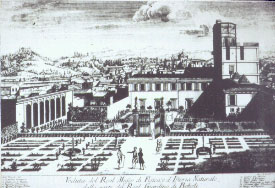 GUELPHS
AND GHIBELLINES
GUELPHS
AND GHIBELLINES
The
period of peace which followed the installation of government under a podestà
did not last long. 1216 saw the beginning of feuds which were to afflict
Florentine society for the entire century, dividing the citizens between Guelphs
and Ghibellines. In 1244 the Ghibelline nobles, who were in power, decided to
broaden the social base of the government, so as to obtain the favor of the
merchant middle class. This was the prelude to the beginning of the period that
was to be known as "Primo Popolo". But only a few years later, in 1250, the
merchants and the artisans as a whole managed to usurp the power of the
Ghibelline nobles and initiate a new political policy.
The Societas militum were abolished, in the hopes of allaying the arrogance of
the nobles and of preventing them from returning to power. So all the towers had
to be cut down to a height of 29 meters. This was the beginning of another
period of peace and prosperity and the city's economic and financial power was
affirmed. Outstanding evidence of this economic expansion was the coining in
1252 of the gold florin, which joined the silver florin coined as early as 1235.
During the period of the "Primo Popolo" the population of the city grew and new
public buildings went up. In 1255 construction began on what was to be called
the Palazzo del Popolo, now the Bargello, which was erected to house the
Councils of the Commune. With its imposing mass and its crenellated tower rising
above all other city towers, it was the expression in architecture of the new
political policy.
At the battle of Montaperti, 1260, the Florentines were defeated by the Sienese
hosts, which resulted in the obliteration of all that the merchant middle class
had accomplished politically. When the Ghibellines resumed power and restored
the old institutions they decreed the destruction of the palaces and towers and
houses which the principal exponents of the Guelph party owned in the city and
in the surroundings. The city was covered with rubble, and 103 palaces, 580
houses and 85 towers were totally demolished not to speak of the partial damage
done to other buildings. For six years Florence was forced to submit to the
outrages of the great Ghibellines and it would have been destroyed had it not
been for the fearless defense of Farinata degli Uberti at the convention of
Empoli. The Ghibellines, fearing the power of the people were forced to accept
the services of Clement IV as peacemaker between the opposing factions. The pope
openly favored the Guelph faction which thus succeeded in reconquering the power
and they reintroduced the political institutions abrogated by the Ghibellines.
In the meantime, two new parties began to shape up among the people at large:
the "Magnati" or entrepeneurs (persons whose aims were deemed dangerous to the
populace as a whole, in other words the noble Guelphs and the repatriated
Ghibellines, mostly large holders of houses and lands) and the "Popolani" or
workers (merchant and artisans organized in guilds and in turn divided into "grassi"
and "minuti" depending on the extent of their interests). In 1293, the
historical process begun in the 12th century was to reach its natural conclusion
- the Magnati were prohibited from taking part in the political life of the
city. In the latter part of the 13th century Florence reached the zenith of its
economic and demographic development. This was the period when great things were
done in the fields of architecture and town planning, made possible by the
formidable accumulations of capital that resulted from the expanding commercial
and financial activities. The population had continued to increase and so new
city walls were needed and in 1282 a belt 8,500 meters long was planned,
enclosing an area of 430 hectares, five times that of the precedent urban area.
These sixth, and last, city walls were the greatest financial commitment ever
undertaken by the Florentine Commune. This was why work went on so slowly,
interrupted more than once because of war and not finished until 1333. Much of
the wall was demolished in the 19th century and only a few tracts, Oltrarno, and
the principal gates still exist.
At the end of the 13th century Florence could rightly consider itself the main
city of the West. The entrepreneurs then in power decided to construct two great
buildings which were in a sense to be symbols of the wealth and power of the
city: the new cathedral and Palazzo della Signoria. Arnolfo di Cambio was the
outstanding figure who designed both buildings, as well as all the other
important works promoted by the government of the Guilds, including the new
walls. In 1296 the reconstruction of the old cathedral of Santa Reparata was
begun. The new building, no longer dedicated to the Palestinian saint, but to
the Madonna, was to undergo various changes in size and plan in the course of
its construction which lasted for almost a century. Arnolfo's bold project was
however basically maintained. The construction of the great Franciscan church of
Santa Croce is also attributed to Arnolfo di Cambio, and represents one of the
most prestigious monuments erected at the end of the 13th century.
When the city and the countryside were organized into districts in 1292 and the
building of the new city walls was begun, a whole new series of urban measures
were undertaken. The numerous towerhouses were flanked by the palaces which the
middle class merchants were building as a symbol and visible sign of their
wealth and power.
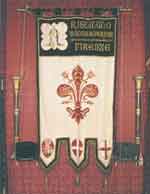 FROM
THE FOURTEENTH CENTURY TO THE RENAISSANCE
FROM
THE FOURTEENTH CENTURY TO THE RENAISSANCE
Towards the end of the 13th century and in the early 14th century the contrasts between the popolo minuto-middle and lower middle classes- and the popolo grasso-wealthy merchants-were accentuated. The latter had a firm grip on the power, but in the 14th century the popolo minuto tried several times to broaden the democratic base of the government by increasing the participation of the Arti minori in the government. In 1378, under the impulse of a movement set in motion by the proletariat, the popolo grasso were obliged to accept an institutional reform which provided for the constitution of new Guilds; Tintori, Farsettai, Dyers, Corseteers and Ciompi, corresponding to the most humble activities and the workers.But due to internal divergent interests and an incapacity to govern, these guilds were unable to withstand the reaction of the large merchant middle classes which soon once more took over power.
The rivalry between two noble families resulted in much dissension and led to
the formation of two antagonistic groups of political factions to be known as
Neri and Bianchi or Blacks and Whites. The former were generally exponents of
the newcomers with easy profits and grouped together the representatives of the
old noble classes and the most intransigent Guelphists. The two parties took
turns at the priorate in the last decade of the 13th century but from then on
the conflict intensified. The Priors were forced to exile the heads of the two
factions, and the situation precipitated. The Neri invoked the intervention of
the pope who sent as his peacemaker Charles of Valois, the brother of Philip Le
Belle, king of France. He openly favored the Neri, and even had the heads of the
Bianchi arrested and forced those who were most compromised, including
Dante Alighieri, into exile.
In addition to these internal struggles, the city had also to sustain the
onerous burden of the wars against the powerful Ghibelline signorias of the
Visconti and the Scaligeri, joined by the Pisans and the Luccans. Two serious
defeats, one in 1315 and the other ten years later, induced Florence first to
ask for the protection of the Angevin troops and then to place themselves under
the direct dominion of Charles, duke of Calabria, of the house of Anjou. The
death of the duke in 1327 unexpectedly restored its freedom to the Florentine
Commune. But it did not end there.A new attempt to take over Pisa and Lucca
failed miserably. The Florentines, defeated by the Ghibelline forces under the
leadership of the lord of Verona, Martino della Scala in 1339, were once more
forced to ask King Robert for aid. This resulted in a brief tyranny until the
people, tired of violence and abuses of power, threw out the tyrant and restored
the civic liberties.
During the 14th century, internal strife and wars were aggravated by famine and
epidemics, particularly the deadly plague of 1348, which aggravated a situation
that was already precarious. Further damage was caused by the disastrous flood
of 1333 which also swept away all the bridges over the Arno except the Rubaconte.
The 14th century was therefore a century of political and economic crisis, it
was a period of decisive juncture common to all Western economies. The crisis
was also reflected in the city's architectural activity which continued at a
much slower pace than before. Building activity turned first of all to finishing
the great undertakings of the end of the 13th century (the walls, the cathedral,
the Palazzo della Signoria, the large monastic complex) and to reconstructing
the bridges which had been destroyed. The first of these to be rebuilt, between
1334 and 1337, was the Ponte alla Carraia, apparently after a design by Giotto.
The reconstructions of the other bridges, from the Ponte Vecchio on, were based
on this bridge. The Ponte Vecchio was built by Taddeo Gaddi in three sweeping
arches with a road much wider than before.
After the impressive expansion of the 13th century, the city began to take shape and what might be called a real town planning policy attempted to provide the buildings with some degree of order and regularity. Throughout the 14th century one provision after another was taken in an effort to broaden the streets or modify their routes and to tear down ramshackle buildings or those with structures which impeded traffic. Naturally the Commune's first obligations were in the reorganization of the city's principal piazzas, Piazza della Signoria and Piazza del Duomo, and streets. As can often still be seen, the buildings from that period have a facade with rough-hewn blocks of pietraforte at least in the bottom part, and a series of regular arches in correspondence to the ground floor. The typical "Florentine" arch consisted of a roundheaded or flat intrados and a slightly pointed extrados.
Read More:
Medieval Florence: The work sites
Read More:
Medieval Florence: The city
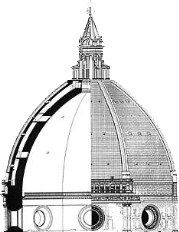 THE
RENAISSANCE
THE
RENAISSANCE
When power returned to the popolo grasso at the end of the 14th century, an oligarchic regime was established in Florence and a small restricted number of the merchant middle class governed the city for about 40 years. However there followed a growing opposition to the oligarchy which was to ably exploit the malcontent of the populace. That part of the middle class which had been excluded from power joined arms with the people and found a leader in Giovanni de' Medici, head of the richest and most powerful company of Calimala. After the death of Giovanni (1429) the contrast was accentuated while the current of opinion favorable to the Medici continued to grow. , Giovanni's firstborn, was lord of the city, although he attempted to conceal the fact, leaving the old republican institutions intact, but emptied of any effective power. , who died in 1464, was followed by the mediochre Piero the Gouty (14641469) whose son, Lorenzo the Magnificent, was to continue his ancestor's dissimulating policy up almost to the end of the century, maintaining the traditional offices, but with no doubts as to what he was to all effects: the true lord of Florence.
During the years in which the merchant oligarchy governed Florence and in the early period of Medici rule, the increasingly frequent contacts with examples of Greek and Roman antiquity gave rise to a new spirit and the city became the center in which Humanism was forged. Man considered himself the ultimate end, eager for rational knowledge and bent on affirming his dominion over the nature which surrounded him and the history which preceded him. Literary culture, the sciences, arts and human activities come to the forefront and it was a golden period in European intellect and culture. Take for example Filippo Brunelleschi; between 1420 and 1446 he created a group of works which were to represent one of the most important moments in the history of Florentine architecture and town-planning. It is then thanks first of all to Brunelleschi and secondly to the other exponents of the architectural culture of the early 15th century that Florence was to present itself from then on as the "Renaissance city" idealized by the humanists. An incredible number of artistic personalities determined the image of the Renaissance city of whom Donatello, Masaccio, Filippo Lippi, Domenico Ghirlandaio, Sandro Botticelli, Beato Angelico, Michelozzo, Giuliano da Sangallo and Benedetto da Maiano are but a few.
Read More: Brunelleschi's Florence
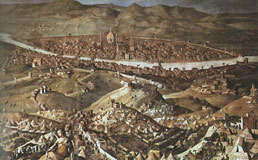 THE
SIXTEENTH CENTURY
THE
SIXTEENTH CENTURY
Lorenzo the Magnificent knew how to impose his personal power without overthrowing the republican institutions. But upon his death in 1492 it took only a few years for the son who succeeded him, Pietro the Unlucky, to demolish the wonderful structure of Medici power. The cowardly policy of Pietro regarding the invader Charles VIII constrained the city to eliminate him and re-establish in full the republican regime. But the people were divided between those who sided with the Medici and the bulk of citizens, inflamed by the sermons of Girolamo Savonarola, who preoceeded to reform the government, imposing a new regime in which an important role was given to a "Gran Consiglio" which reunited the members of the principal families. But it was not long before the Medici and their supporters made a comeback, thanks to the fact that Savonarola had been judged a heretic and burned at the stake in the Piazza della Signoria on May 23, 1498 on the order of Pope Alexander VI.
This was when Michelangelo created his famous statue of David to be located in front of the Palazzo della Signoria as guardian to the Florentine freedom. Afterwards the city once more found itself under Medici rule, at the behest of the pope, allied with the king of Aragon whose word was law in Italy after the departure of the king of France. The elevation to the papal throne, first of Giovanni de' Medici in 1512, and then of Giulio (Clement VII) seemed to reinforce the Medici signoria even more. But when news of the sack of Rome in 1527 arrived, the people rebelled and once more ousted the Medici and proclaimed their freedom. This was the last desperate attempt to reinstate the republican government. On August 12, 1530, after an eleven-month siege, the armies of the emperor and the pope together entered Florence and the following year, with imperial concession, Alexander de' Medici was declared "head of the government and of the state".
The new lord, whom a subsequent resolution was to call "Duke of the Florentine Republic", installed a tyranny, with new institutions all under his control, and began a foreign policy of alliances with the most important reigning families in Europe, marrying a natural daughter of Emperor Charles V and giving his stepsister Caterina as wife to the second son of Francis I.
The adversaries of the Medici, headed by Filippo Strozzi, tried in vain to
overturn Duke Alessandro's government. They were unsuccessful even when
Lorenzino de' Medici assassinated Alessandro in 1537. The only possible
successor was Cosimo il Giovane, son of Giovanni delle Bande Nere, a younger
branch of the family, since the line of Cosimo the Elder had been extinguished.
At seventeen the new duke managed to command respect and gradually installed an
autocratic regime. In his lifetime he succeeded in crushing the adverse factions
and reinforcing the state, bringing Siena under Florentine rule in 1555. He
obtained a sovereign title from the pope and on March 5th 1570 was crowned grand
duke of Tuscany by Pius V. When he died in 1574 he left the government in the
hands of his son Francesco who reigned till 1587 when he was succeeded by his
brother Ferdinando I (1587-1609).
Read More:
Florence
in the '500: The Age of Cosimo
Read More:
Florence in the '500: "Trionfo Maniera"
THE GREAT NAMES OF THE SIXTEENTH CENTURY
Leonardo, although he had made his name in the Medici court, where the work the family commissioned was intended to bring glory to their name, carried out his initial artistic experiences in Florence, where he stayed until 1482, when he left Florence to go to Milan as he did not conform with the Court's philosophy and hence was not happy amongst the Medici. On his return in 1500 the city was still Republican, but it would not be so for much longer (1512). The vague neo-platonic and evasive ideology had now been replaced by Machiavelli's harsh empirical conception of the modern state. Michelangelo and Raffaello had already created a different artistic atmosphere in Florence and, whilst Leonardo was artistically involved in Milan, Michelangelo moved the centre of art to Rome in 1504.
The great new patrons of this period were Popes Clement VII, Julius II and Leo
X. Raffaello came to Florence from Urbino in the same year as
Michelangelo's departure for Rome. He stayed there for four years, long
enough to leave a trace of his different conception of art as a means of
justifying its own ends and as the fulfilment of the ideal form and technical
perfection. Together with the complex and dramatic in heritance left by
Michelangelo and the refined restless sensitivity of Leonardo, form the
basis of Mannerism.
Michelangelo returned from Rome in 1516 to design the facade of San Lorenzo
Church on request of Pope Leo X, a Medici. This appointment was later cancelled
and converted into a project for the Church vestry for the tombs of Lorenzo and
Giuliano dei Medici. In the main room and the hall of the Laurenziana Library,
with its dominating central staircase giving the impression of a cascading wave
of a waterfall, supported on the side by the balustrade and the thick line of
high stairs,
Michelangelo anticipates the characteristic of the Baroque style, which
tends to force space inwards.
Following the seige of Florence by the Spanish in 1529 and the fall of the
Republic, in the meantime re-established by Duke Alessandro dei Medici,
Michelangelo was forced to leave Florence again. In 1534 he was re-called to
Rome to undertake the Sistine Chapel frescoes. Meanwhile the aspect of the town
of Florence, until then made up of streets and 15th and 16th Century palaces,
with internal courtyards and gardens, began to tend towards spacious piazzas,
where meetings and theatrical representations were held. Giorgio Vasari,
painter, architect, art historian, transformed the Palazzo degli Uffizi into a
large urban hall. Bartolomeo Ammannati, sculptor and architect, transforms
Palazzo Pitti into a long gable-surfaced structure. Bernardo Buontalenti who
succeeded Ammannati as architect to the Medici family, provided the most lively
example of the versatility of culture of that period. This extraordinarily
versatile character was capable of reverting from urbanistic planning of the
town of Livorno to designing jewels for the Grand Duchess and also prepared the
plans for the Fortezza di Belvedere.
 THE
DECLINE OF THE MEDICI
THE
DECLINE OF THE MEDICI
Ferdinando
I (1587-1609) continued his father's policy and succeeded in strengthening the
grand duchy, maintaining a difficult equilibrium between France and Spain. Signs
of decadence became more obvious under the government of the two sons of I's and
were accelerated in the 17th century. Florence was still a great city, but its
territory was small and it could certainly not compete with the great and
powerful centralised states. Economically the situation had also changed. Trade
and manufacturing were on the decline and, at least up to the end of the 16th
century, only banking was still carried out on a European level, but in the end
that too declined.
Ferdinando I was succeeded by the sickly II (1609-1621) who died leaving the
government in the hands of his wife Maria Magdalena of Austria and his mother
Christine of Lorraine. In 1628, when the period of the regency came to an end,
Ferdinando II mounted the throne and reigned until 1670. Even though he was
reputed to be among the best of the Medici dynasty, he could do nothing to
arrest the inexorable decline of Florence and of the Tuscany of the grand dukes.
Nor could his successors, III (1670-1723) and the last of the Medici dynasty,
Gian Gastone, who died without heirs in 1737. Even so, as far as culture was
concerned, the city, by now condemned to a provincial role, still displayed a
certain vitality which expressed itself in the field of music and in the
phenomenon of the Academies. From the late 16th century and throughout the 17th
century numerous academies of pure literature came into being. The Accademia
della Crusca whose principal labour was the compilation of the Dictionary, the
first edition of which appeared in 1612, was founded in 1582. Of great
importance for the sciences was the activity of the Accademia del Cimento,
founded by Leopoldo de' Medici in 1657 and sustained by his brother, the
reigning Ferdinando II. Both were pupils of Galileo, the only man of genius the
17th century produced in the grand duchy.
 THE
LORRAINE PERIOD
THE
LORRAINE PERIOD
After the death of Grand Duke Gian Gastone, the last Medici, the important European countries in Vienna decided to give Tuscany to Francis I Duke of Lorraine, French-Austrian dynasty. He was succeeded by Peter Leopold I, Ferdinando II, Ferdinando III and finally by Leopoldo II.
While the arrival of the Lorraine family in Florence revived the town's economy,
it unfortunately also accentuated its provincial mentality which prevented
Florence from participating in international cultural expansion and the
consequences for the town lasted for a long while. In the face of this the
techniques of Ammannati and Buontalenti greatly influenced architecture and this
can be seen in the works of Pierfrancesco Silvani, Foggini, and, at the turn of
the 18th Century, Ruggieri. In the mid-18th Century, when international culture
was once more open to discussion, the Lorraines asked the Frenchman Jadot to
come to Florence to9 provide a neo-Classical touch. Neo-classicism in Florence
is of strong historical flavour, good taste and elegance seen in the little
Meridiana palace in Boboli and the White Room in Palazzo Pitti, among others.
Meanwhile the upturn in the economy was testified by the lenghthening Via Larga,
two new bridges were built and the roads along the banks of the Arno were
extended beyond the city walls, whilst the poor districts became more and more
built-up. When Leopold II of Lorraine again gained control of the town, assisted
by the Austrian troops, in an atmosphere of imminent social crisis and flare-up
of class warfare, the ideals of beauty and elegance of the neo- classical period
were substituted by the enlightening theory to return to nature and the liberty
of mankind. The increasing contrast between the expansion of the new residential
districts near the city walls and the disquieting continual increase in the
number of people living in the poor quarters, were the main cause of social
warfare and revolutions, whilst the birth of industrial economy emphasised the
problem of the working classes' conditions.
Read More: Florence in the 17th and 18th centuries
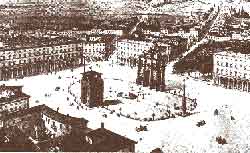 FLORENCE
AS A CAPITAL CITY
FLORENCE
AS A CAPITAL CITY
In 1859 the Lorraines left Florence for good. Following that and after the Second War of Independence and after Tuscany joined the Savoy Reign of Unified Italy, Florence was the capital of Italy for 5 years from 1865 to 1870. The historical city centre underwent intensive urban renovation, which completely destroyed the Old Market and its Jewish quarter, near to the present day Piazza della Repubblica. The square can be seen to represent the destruction of a thousand years of urbanistic stratification, substituted with an anonymous geometrical layout of buildings, amongst which some monuments have been left intact, emerging with no connection to the buildings around them.
Read More: Florence in the '800
FLORENCE IN THE '900
Throughout this century, Florence has been suffering from a process of degradation. The old structure can no longer cope with the demands of modern urban life and has become the "problem" of a complex reality. Its meaning must be recuperated in a new context which never quite reaches an organic equilibrium to thus become a new and successful urban form.
After Giuseppe Poggi's plan for "Florence, capital of Italy" (1864-1870) and its
implementation - with demolition of the city walls to construct the ring road
boulevards, creation of Viale dei Colli and Piazzale Michelangelo and the
initial development of new residential districts both inside the ring road (the
Mattonaia district around Piazza dell'Indipendenza and the Maglio district
around Piazza d'Azeglio) and outside (Savonarola, San Jacopino, Piagentina) -
and after demolition of the city centre around the old market (1885-1889) to
create the grand Piazza Vittorio Emanuele II (now Piazza della Repubblica) and
construct buildings mainly intended for office use, thus beginning the
tertiarisation of the city centre, in the first decades of the 20th century, in
line with Poggi's urban planning scheme, the city spread rapidly as far as the
foothills - to Via Vittorio Emanuele II to the west, to Viale Volta to the east
and across the Arno along Via Pisana beyond Pignone, where the foundry
represented the first industrial nucleus together with the associated workers'
housing.
Until the First World War, the city's problems apparently accumulated without
tangible intervention from the public authorities. On a social level, the
workers' movement developed in defence of a class living in great hardship.
Between 1890 and 1915, the population grew by fifty thousand. Between 1905 and
1913, 36,652 rooms were constructed and about 2,000 low-rent dwellings were
built. The terraces of middle class two-storey houses known as "trenini" ("toy
trains") from Ricorboli to San Gervasio and from the Mugnone valley to San
Jacopino and Rifredi are a somewhat provincial version of a modern European form
which, however, now appears as not devoid of quality in its neatness and dignity
with respect to the constructional anarchy of today.
The character of the new middle class residential areas emerges from this
passage by Aldo Palazzeschi: "Two months later, I found myself on the opposite
side of the city in what were - and still are - the new districts of Florence at
Barriera delle Cure, known to the Florentines simply as alle Cure. Here the
farmland has only recently started to be licked, violated, strewn and invaded by
the new buildings. Farewell to the grand and austere mansions, the severe and
magnificent architecture, the cantilever roofs, capitals and cornices. Another
life, another light, a different air.
